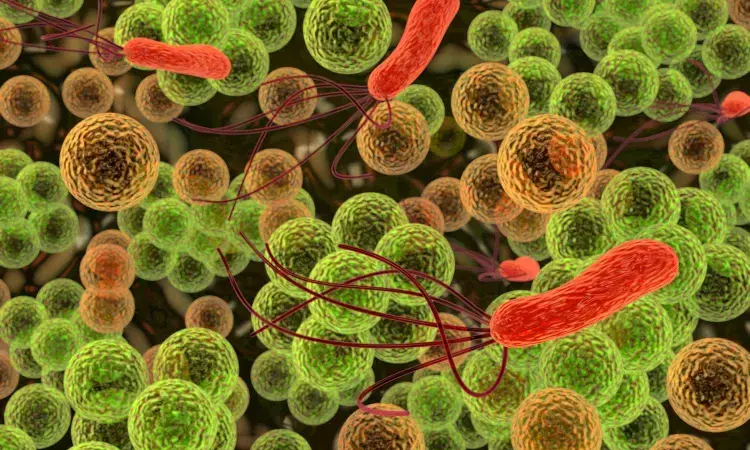- Home
- Medical news & Guidelines
- Anesthesiology
- Cardiology and CTVS
- Critical Care
- Dentistry
- Dermatology
- Diabetes and Endocrinology
- ENT
- Gastroenterology
- Medicine
- Nephrology
- Neurology
- Obstretics-Gynaecology
- Oncology
- Ophthalmology
- Orthopaedics
- Pediatrics-Neonatology
- Psychiatry
- Pulmonology
- Radiology
- Surgery
- Urology
- Laboratory Medicine
- Diet
- Nursing
- Paramedical
- Physiotherapy
- Health news
- Fact Check
- Bone Health Fact Check
- Brain Health Fact Check
- Cancer Related Fact Check
- Child Care Fact Check
- Dental and oral health fact check
- Diabetes and metabolic health fact check
- Diet and Nutrition Fact Check
- Eye and ENT Care Fact Check
- Fitness fact check
- Gut health fact check
- Heart health fact check
- Kidney health fact check
- Medical education fact check
- Men's health fact check
- Respiratory fact check
- Skin and hair care fact check
- Vaccine and Immunization fact check
- Women's health fact check
- AYUSH
- State News
- Andaman and Nicobar Islands
- Andhra Pradesh
- Arunachal Pradesh
- Assam
- Bihar
- Chandigarh
- Chattisgarh
- Dadra and Nagar Haveli
- Daman and Diu
- Delhi
- Goa
- Gujarat
- Haryana
- Himachal Pradesh
- Jammu & Kashmir
- Jharkhand
- Karnataka
- Kerala
- Ladakh
- Lakshadweep
- Madhya Pradesh
- Maharashtra
- Manipur
- Meghalaya
- Mizoram
- Nagaland
- Odisha
- Puducherry
- Punjab
- Rajasthan
- Sikkim
- Tamil Nadu
- Telangana
- Tripura
- Uttar Pradesh
- Uttrakhand
- West Bengal
- Medical Education
- Industry
Hospital surfaces can harbor harmful microbes even after routine disinfection, finds study

A new study published today in the American Journal of Infection Control (AJIC) reports microbial contamination-including pathogenic and potentially pathogenic bacteria-on high-touch hospital surfaces despite compliance with recommended disinfection protocols. The findings shed light on the persistent challenge of reducing healthcare-associated infections (HAIs) and indicate that innovative strategies may be needed for more effective disinfection of these surfaces.
The risk of microbial contamination on hospital surfaces is a well-known factor in the spread of HAIs, and it has led to carefully established disinfection procedures to keep patients and healthcare workers safe. But as this new study demonstrates, current best practices in routine hospital disinfection may not be sufficient to prevent the spread of pathogens, particularly for surfaces that are frequently touched by many different people.
The study was conducted at the Central Texas Veterans Healthcare System, where researchers collected samples from 400 surfaces between June and July of 2022. They focused on high-touch surfaces such as simulation manikins used for resuscitation practice, workstations on wheels, breakroom tables, bed rails, and computer keyboards at nurse’s stations. All of these surfaces were found to harbor bacteria, and manikins and bed rails also had the most diverse types of bacteria.
A total of 60 different kinds of bacteria were identified across all samples, including 18 well-known human pathogens and a number of bacteria that can be pathogenic to humans under certain circumstances. The most common types of known pathogenic bacteria included Enterococcus, Staphylococcus aureus, Streptococcus, Escherichia coli, and Klebsiella aerogenes, among others. Some of the potentially pathogenic types of bacteria have been associated with central-line associated bloodstream infections, meningitis, and endocarditis. About half of the bacteria identified through these samples were also found in clinical samples collected from patients during 2022.
“It is a continuing frustration to healthcare professionals that HAIs persist despite rigorous attention to disinfection practices,” said Piyali Chatterjee, PhD, Research Scientist at Central Texas Veterans Healthcare System and senior author of this paper. “Our study clearly shows the bioburden associated with high-touch hospital surfaces-including simulation manikins, which are not typically regarded as a risk because patients rarely touch them-and indicates that we must do better in protecting the health of our patients and our hospital employees.”
“This study underscores the critical value of infection prevention and control efforts in our healthcare systems,” said Tania Bubb, PhD, RN, CIC, FAPIC, 2024 APIC president. “By understanding the gaps in our current disinfection protocols, we can focus on developing more effective protocols and education strategies to prevent the spread of dangerous organisms and better protect patients and healthcare workers from HAIs.”
Reference:
Chetan Jinadatha, Thanuri Navarathna, Juan Negron-Diaz, Gautam Ghamande, Brandon A. Corona, Andres Adrianza, John D. Coppin, Hosoon Choi, Piyali Chatterjee,Understanding the significance of microbiota recovered from health care surfaces, American Journal of Infection Control, DOI:https://doi.org/10.1016/j.ajic.2023.11.006
Dr Kamal Kant Kohli-MBBS, DTCD- a chest specialist with more than 30 years of practice and a flair for writing clinical articles, Dr Kamal Kant Kohli joined Medical Dialogues as a Chief Editor of Medical News. Besides writing articles, as an editor, he proofreads and verifies all the medical content published on Medical Dialogues including those coming from journals, studies,medical conferences,guidelines etc. Email: drkohli@medicaldialogues.in. Contact no. 011-43720751


